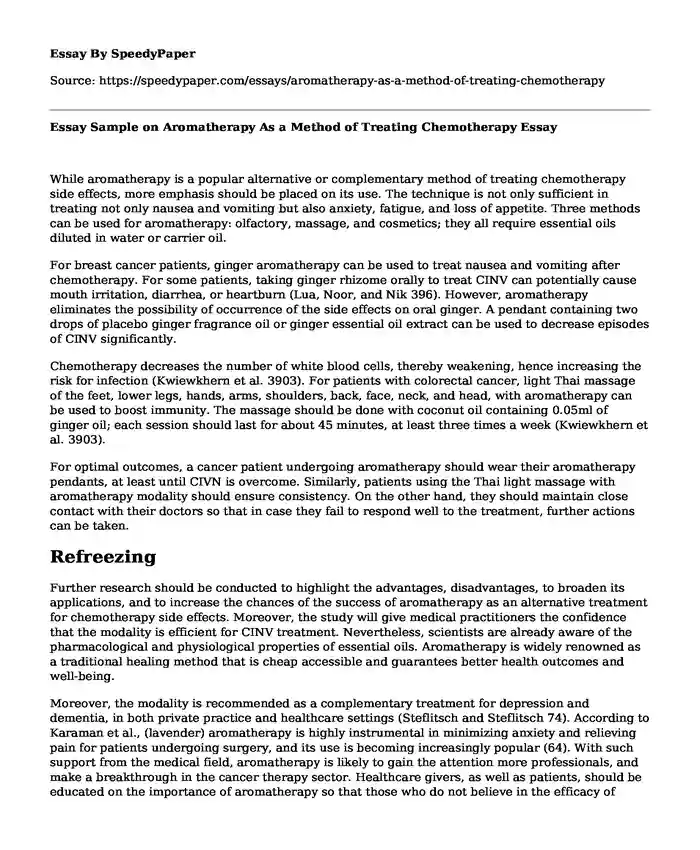
| Type of paper: | Course work |
| Categories: | Medicine Pharmacology Cancer |
| Pages: | 3 |
| Wordcount: | 681 words |
While aromatherapy is a popular alternative or complementary method of treating chemotherapy side effects, more emphasis should be placed on its use. The technique is not only sufficient in treating not only nausea and vomiting but also anxiety, fatigue, and loss of appetite. Three methods can be used for aromatherapy: olfactory, massage, and cosmetics; they all require essential oils diluted in water or carrier oil.
For breast cancer patients, ginger aromatherapy can be used to treat nausea and vomiting after chemotherapy. For some patients, taking ginger rhizome orally to treat CINV can potentially cause mouth irritation, diarrhea, or heartburn (Lua, Noor, and Nik 396). However, aromatherapy eliminates the possibility of occurrence of the side effects on oral ginger. A pendant containing two drops of placebo ginger fragrance oil or ginger essential oil extract can be used to decrease episodes of CINV significantly.
Chemotherapy decreases the number of white blood cells, thereby weakening, hence increasing the risk for infection (Kwiewkhern et al. 3903). For patients with colorectal cancer, light Thai massage of the feet, lower legs, hands, arms, shoulders, back, face, neck, and head, with aromatherapy can be used to boost immunity. The massage should be done with coconut oil containing 0.05ml of ginger oil; each session should last for about 45 minutes, at least three times a week (Kwiewkhern et al. 3903).
For optimal outcomes, a cancer patient undergoing aromatherapy should wear their aromatherapy pendants, at least until CIVN is overcome. Similarly, patients using the Thai light massage with aromatherapy modality should ensure consistency. On the other hand, they should maintain close contact with their doctors so that in case they fail to respond well to the treatment, further actions can be taken.
Refreezing
Further research should be conducted to highlight the advantages, disadvantages, to broaden its applications, and to increase the chances of the success of aromatherapy as an alternative treatment for chemotherapy side effects. Moreover, the study will give medical practitioners the confidence that the modality is efficient for CINV treatment. Nevertheless, scientists are already aware of the pharmacological and physiological properties of essential oils. Aromatherapy is widely renowned as a traditional healing method that is cheap accessible and guarantees better health outcomes and well-being.
Moreover, the modality is recommended as a complementary treatment for depression and dementia, in both private practice and healthcare settings (Steflitsch and Steflitsch 74). According to Karaman et al., (lavender) aromatherapy is highly instrumental in minimizing anxiety and relieving pain for patients undergoing surgery, and its use is becoming increasingly popular (64). With such support from the medical field, aromatherapy is likely to gain the attention more professionals, and make a breakthrough in the cancer therapy sector. Healthcare givers, as well as patients, should be educated on the importance of aromatherapy so that those who do not believe in the efficacy of complementary treatment can change their perception.
To validate the efficacy of the shift from traditional methods of CINV treatment to aromatherapy, further analytical and comparative studies will be conducted. As more patients will be subjected to the procedure, their responses will be analyzed to gauge their satisfaction with the method. Essential oils from different plants will be used to test to which individual patients will respond better, and the level of change they cause on the patient's health. Conclusively, higher patient satisfaction will mean that aromatherapy is not only cheaper but also better for CINV treatment, especially for patients who are unresponsive to other techniques.
Works Cited
Karaman, Tugba, et al. "Evaluating the efficacy of lavender aromatherapy on peripheral venous cannulation pain and anxiety: A prospective, randomized study." Complementary therapies in clinical practice 23 (2016): 64-68, doi.org/10.1016/j.ctcp.2016.03.008.
Khiewkhern, Santisith, et al. "Effectiveness of aromatherapy with light Thai massage for cellular immunity improvement in colorectal cancer patients receiving chemotherapy." Asian Pacific Journal of Cancer Prevention 14.6 (2013): 3903-3907, dx.doi.org/10.7314/APJCP.2013.14.6.3903
Lua, Pei Lin, and Noor Salihah Zakaria. "A brief review of current scientific evidence involving aromatherapy use for nausea and vomiting." The Journal of Alternative and Complementary Medicine 18.6 (2012): 534-540, doi.org/10.1089/acm.2010.0862
Steflitsch, Wolfgang, and Michaela Steflitsch. "Clinical aromatherapy." Journal of Men's Health 5.1 (2008): 74-85, doi.org/10.1016/j.jomh.2007.11.001
Cite this page
Essay Sample on Aromatherapy As a Method of Treating Chemotherapy. (2023, Apr 05). Retrieved from https://speedypaper.com/essays/aromatherapy-as-a-method-of-treating-chemotherapy
Request Removal
If you are the original author of this essay and no longer wish to have it published on the SpeedyPaper website, please click below to request its removal:
- Essay Sample for You: Tips and Tricks of Being a Good Student
- Eating Disorder Essay Sample: The Thin Film Analysis
- Beethoven Hero - Free Essay on the Composer's Biography
- Business Essay Sample: Food Truck in Hong Kong
- Essay Sample Describing Ethics in Business
- Paper Example. Supervised Drug Injections Sites: A Positive Force
- Essay Sample on Short-Term Investment Returns: Money Market Instruments
Popular categories




